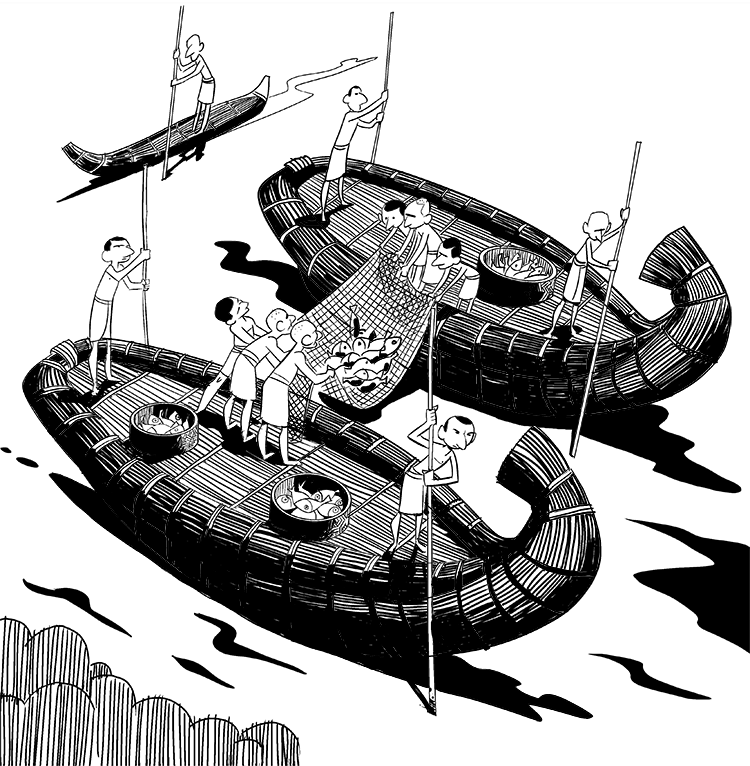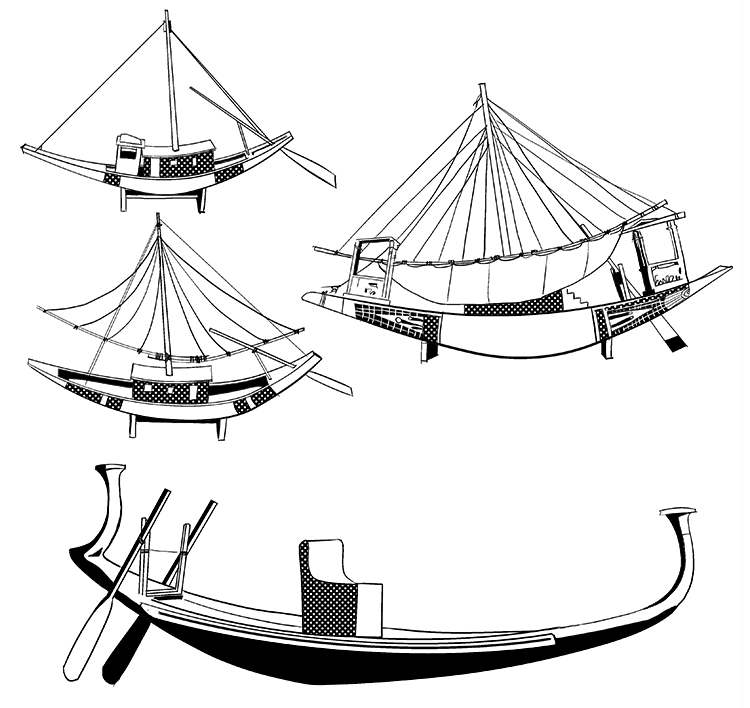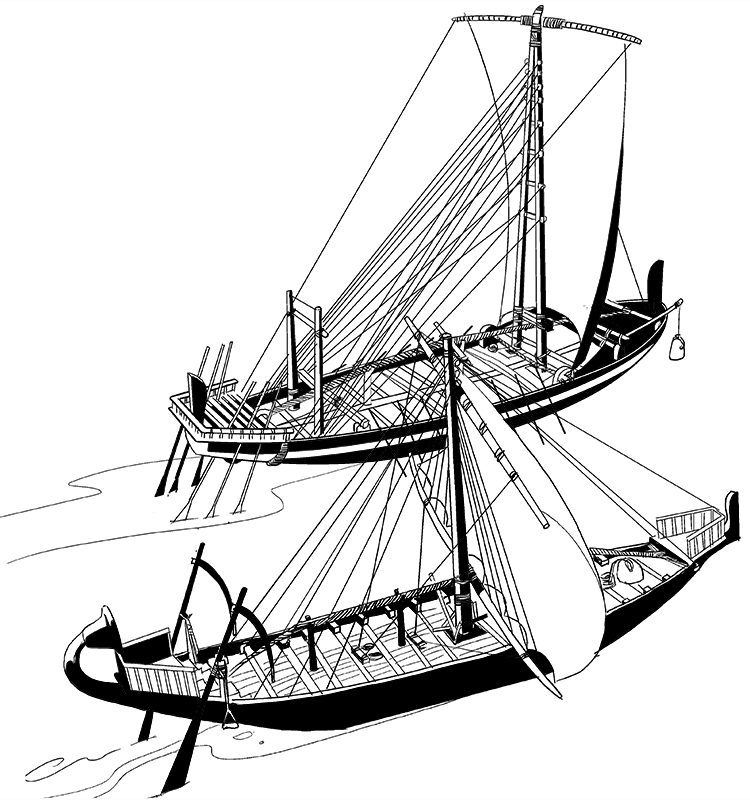When most of us think of Egypt, the first things that come to mind are pyramids, the Nile River, and the desert.
One of the last things that comes to mind is ships and the sea.
Yes, you can probably figure out that the Egyptians used boats to move up and down the river, but you probably didn’t know that the Egyptians were some of the most prolific shipbuilders of the ancient world.
The Importance of Ships in Ancient Egypt
Daily life in Ancient Egypt centered around boats. Without one, it was hard to do most of the things people needed to do to live their lives.

Transportation
The primary reason it was so important to have a boat was for transportation. There were very few roads in Ancient Egypt because Mother Nature had already built the best one possible: the Nile River.
All of the important cities and towns in Ancient Egypt were located along the Nile River, so anyone wanting to travel between them needed a boat.
Of course, travel wasn’t exactly a hobby for people back in ancient times as it is now. But there was still a need to move between cities to acquire supplies, visit religious sites, and conduct other business of daily life.
Another reason the Egyptians took to boats so much was because of how easy it was to use them. Specifically, the Nile’s current flows south and the winds in Egypt almost always blow south. This made it so that boats could use the current going one direction and then raise sails to go the other.
Because boats were so important, the Egyptians didn’t learn the concept of the wheel until much later in their history, and they actually got the idea from somewhere else.
To them, rolling things on the ground just didn’t make any sense.

Trade
Trade was a major driver of progress in Ancient Egypt. Trade within Egypt helped make sure everyone had enough to eat and contributed to political unity. And Egypt made friends with other cultures and grew their influence by trading their surpluses of wheat and gold for wood, metal, and other precious stones.
It was through trade that Egypt became so wealthy and powerful, and the bulk of their trading was done over water.
This is because all around the Nile Delta and valley was a barren desert. There were some land routes to other places, but the trip was treacherous. It was much easier to jump on a boat and sail across the Mediterranean or Red Sea.
Egyptian traders did venture to far off lands, but not as often as merchants from other cultures. Instead, they could simply sail to the mouth of the Nile River and meet traders from other places.
There they would exchange goods and then sail back down the Nile, distributing goods as they went.
This made life as an Egyptian trader pretty, pretty good. They just had to sit back and wait for the luxuries of the world to come to them.

Papyrus Boats
Papyrus Boats were the cheapest and most commonly used ship for transportation and fishing.
The Many Boats of Ancient Egypt
The first boats the Egyptians built were made of papyrus, which is basically a reed. They were super simple to construct but they weren’t all that “good.” They could only operate in shallow waters and were propelled by poles. Not exactly fit for the high seas. But they were quite effective at helping people navigate the calm waters of the Nile River.
These papyrus boats, which were cheap and easy to make, remained the preferred mode of transportation for Egyptian commoners even after they learned how to build bigger and better ships.
Eventually, as the Egyptians started to grow and make contact with the world, they began to build wooden ships with sails. This allowed them to move upstream and out into the Mediterranean, connecting Egypt to the world.
Once they got pretty good at making these boats, they started creating larger and larger models, mainly for the purpose of overseas trade.
These “cargo ships” could carry up to 500 tons of stuff, and it’s believed they were used to help transport the stones that make up the Great Pyramids of Giza and other major construction projects.
Building these boats became an industry in Ancient Egypt. Not only did they need ships for themselves, but they would also sell them to other cultures who didn’t have the skills to build their own.

Funeral Boats
Boats were also important in the afterlife. Models of sea going and fishing boats have been found in many Egyptian tombs along with the ceremonial ship to cross to the afterlife.
Boats and Egyptian Religion
Ships were so important to daily life in Ancient Egypt that they also took on considerable significance in Egyptian religion.
For example, they believed that the gods used boats to move across the universe and carry out their cosmic duty, and it was common for people to build boats with shrines to the gods and set them down the river.
They also thought that one needed a boat to journey to the heavens and enter the after life. This might not be our idea of a Nile River cruise, but getting on a boat and ending up in eternal paradise doesn’t sound all that bad, now does it?

Sea Ships
The Egyptians not only mastered river navigation, they sailed and traded goods with other nations using sea ships like these.
Egyptian Sailors Make Their Mark
The Egyptians were not only good at building boats, but they were also excellent sailors. All those millennia of moving up and down the Nile seem to have paid off.
Because of this, Egyptian sailors played an important role in the many conflicts of the ancient world. No matter if it was the Greeks fighting the Persians, the Assyrians fighting the Palestinians, or the Romans battling everyone, Egyptian sailors and ships were almost always present.
Over time, Egyptian culture was absorbed first into Greek and then Roman way of life. But part of the reason the ambitious rulers of these faraway lands sought out Egypt was because of the wealth and power they had established through their mastery of ships and the seas.
Written by Matthew Jones
Illustrated by Pablo Velarde Diaz-Pache
